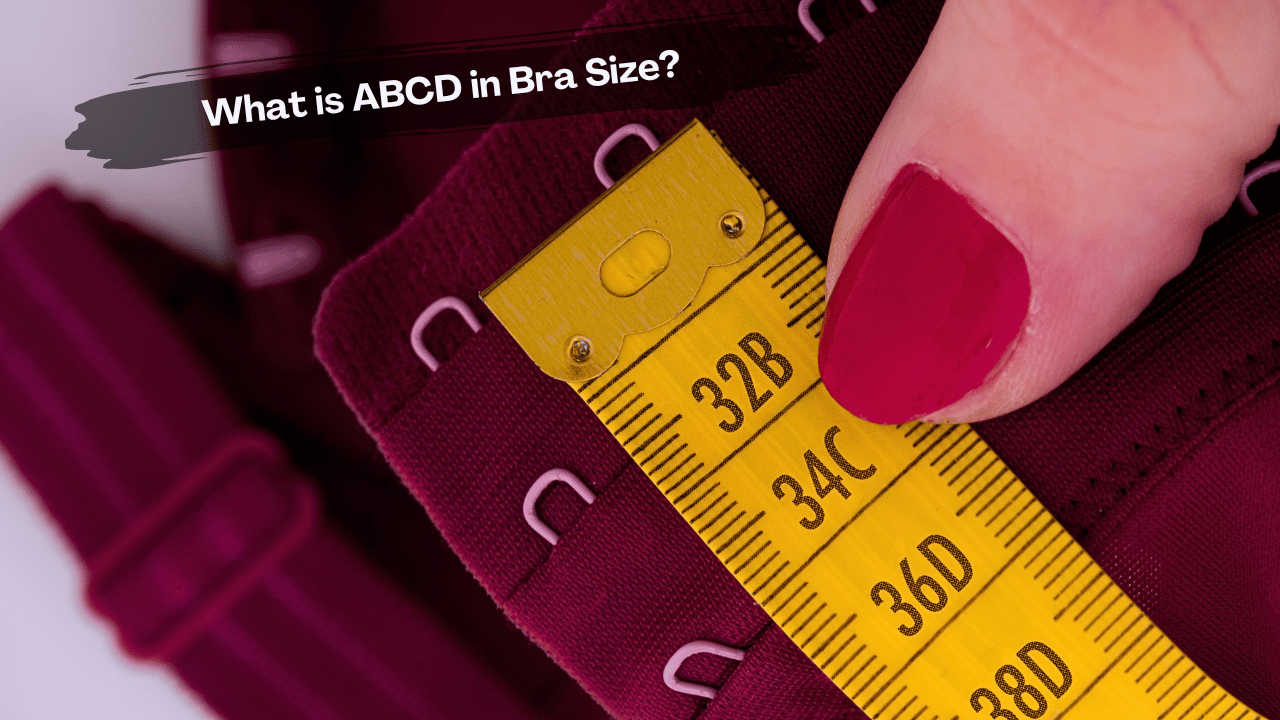Have you ever been shopping for bras and come across sizes like ABCD? Understanding bra sizes can be quite confusing, especially with the seemingly random combination of letters.
In the world of lingerie, bras play a significant role in providing support, comfort, and shaping for women’s breasts. You might have noticed that bras are often labeled with letters like A, B, C, or D, followed by a number, such as 34B or 36D. These letters represent cup sizes, and they are an essential aspect of bra fitting.
So, let’s break down the ABCD in bra size and explore the intricacies of this important aspect of lingerie shopping.
The Birth of Bra Sizing
The concept of bras can be traced back to ancient civilizations where women used rudimentary pieces of fabric to support their breasts. However, it wasn’t until the late 19th century when the first true bra was patented.
Initially, bras were manufactured in standard sizes, failing to accommodate the varying shapes and sizes of women’s bodies. As the demand for more comfort and better fit grew, lingerie companies began to experiment with different sizing techniques.
During the early 20th century, the concept of cup sizes was introduced, allowing for a more precise fit. The ABCD system was introduced by the S.H. Camp and Company, which later became known as Maidenform, In October 1932, The system aimed to standardize bra sizing, making it easier for women to find the right fit. The letters A, B, C, and D were used to categorize the cup sizes, with A being the smallest and D being larger.
However, as the demand for more inclusive sizing increased, additional cup sizes were introduced, leading to a more comprehensive range that could cater to women of all body types.
As time passed, advancements in technology, materials, and understanding of women’s bodies further refined bra sizing, making it an essential aspect of undergarment design today. With a wide array of sizes, styles, and designs, modern bras continue to evolve to provide the best possible fit and support for women worldwide.
Why do bras have ABCD?
The use of letters for bra cup sizes originated in the 20th century when the lingerie industry sought a more straightforward and standardized approach to sizing. The letters A, B, C, and D were chosen to represent incremental differences in cup volume. This system allowed manufacturers to offer a wide range of sizes to accommodate various breast shapes and sizes effectively.
Understanding the ABCD Bra Sizing System
The ABCD system is the most common way to represent bra sizes and refers to the cup size.
Each letter corresponds to a specific cup size, and the numbers indicate band size, which is the measurement around a woman’s rib cage just below her bust. The cup size is determined by calculating the difference between the band size and the fullest part of the breasts.The cup size increases with each letter, with A being the smallest and D being larger.
A Cup: A is the smallest cup size, generally suitable for individuals with smaller breasts.
B Cup: B is the next size up, offering slightly more room in the cup than an A cup.
C Cup: C is a medium-sized cup, providing more coverage and support than A and B cups.
D Cup: D is the largest of the four, designed for individuals with more substantial breast tissue.
It’s important to note that the band size, which refers to the measurement around the ribcage, complements the ABCD system to form a complete bra size (e.g., 34A, 36B, 32C, 38D, etc.).
Decoding Band Size (The Number)
The band size is the numerical aspect of your bra size and plays a crucial role in providing support and comfort. Band sizes typically range from 28 to 48, with smaller increments in between. To measure your band size accurately, wrap a measuring tape around your ribcage, right under your bust. Make sure the tape is snug but not too tight, and round the measurement to the nearest whole number.
For example, if you measure 31 inches, your band size will be 32.This number will be your band size. Remember that the band provides the majority of the support, so it should fit comfortably and remain level around your body.
Decoding Cup Size (The Letter)
The cup size represents the volume of the breast and is determined by the difference between your band size and the fullest part of your bust. Cup sizes come in various letters, starting from A and going up in alphabetical order. The cup size represents the difference between your band size and the fullest part of your bust. To measure your cup size, wrap the measuring tape around your bust, making sure it’s level across your nipples. Subtract your band size from this measurement, and the resulting number corresponds to your cup size. For instance, a 1-inch difference would be an A cup, a 2-inch difference a B cup, and so on.
Here’s a quick guide to understanding cup sizes:
1-inch difference: A cup
2-inch difference: B cup
3-inch difference: C cup
4-inch difference: D cup
ABCs of Bra Sizes
Now that we’ve decoded the numerical and alphabetical components of bra sizing let’s delve into the ABCD of bra sizes and understand what each size signifies
A Cup: An A cup size indicates that there is a 1-inch difference between your band size and bust measurement. This size is ideal for women with relatively smaller breasts and provides light support and modest shaping.
B Cup: A B cup size signifies a 2-inch difference between your band size and bust measurement. This size offers slightly more support and shaping compared to an A cup and is suitable for women with moderately sized breasts.
C Cup: A C cup size means there is a 3-inch difference between your band size and bust measurement. C cups offer a more generous coverage and support, making them suitable for women with medium-sized breasts.
D Cup: A D cup size represents a 4-inch difference between your band size and bust measurement. This size provides ample support, lift, and shaping, making it an excellent choice for women with larger breasts.
Determining Your Bra Size – The Chart:
To make the process of finding your perfect bra size easier, refer to the following chart:
Please note that sizes can vary slightly between brands, so it’s essential to try on different bras to find the best fit for you.

Sister Sizing
Sister sizing is a valuable technique when shopping for bras. It involves finding bras with different band sizes but equivalent cup volumes. For example, a 34C bra has the same cup volume as a 32D or a 36B. Understanding sister sizes allows you to explore more options and find the perfect fit, even if your exact size is unavailable.This is especially helpful when trying bras from different brands, as their sizing may vary slightly. The idea behind sister sizes is to give you more options when shopping for bras, especially if your exact size is not available in a particular style.
Finding your sister size is easier than you might think. To do this, you need to understand the relationship between band sizes and cup sizes. For every decrease in band size, you’ll need to go up by one cup size to maintain the same volume, and vice versa. Online bra size calculators and charts can be incredibly helpful in determining your sister size.
Misconceptions about Bra Sizing
There are several misconceptions surrounding bra sizing that can lead to ill-fitting bras and discomfort. Some of these misconceptions include the belief that the band size should be very tight for proper support or that all bras with the same cup size will fit the same way. Dispelling these myths can lead to a better understanding of bra fitting.
Misconceptions About Cup Sizes
One of the most prevalent misconceptions is that a larger cup size always means bigger breasts. However, this is not entirely accurate. Cup size is relative to band size, meaning a 32C bra has smaller cups than a 36C bra. In this case, the latter has a larger band size and accommodates more volume. Thus, cup size alone cannot determine breast size accurately
Common Bra Fitting Mistakes
Understanding bra sizes is crucial, but there are common mistakes to avoid:
Wearing a Loose Band
A loose band compromises support and causes the bra to ride up your back. Ensure a snug fit without feeling constricted.
Overlooking Cup Spillage
Cup spillage indicates a too-small cup size. Upgrade to a larger cup to prevent discomfort and achieve a smooth silhouette.
Neglecting to Adjust Straps
Tighten or loosen the straps to achieve the desired lift and support. Ill-adjusted straps can dig into your shoulders or lead to a sagging bust.
Bra Size Fluctuations
A woman’s bra size can change over time due to various factors, such as weight fluctuations, hormonal changes, pregnancy, or aging. Being aware of these potential changes will help you recognize when it’s time to reevaluate your bra size and invest in new bras for better comfort and support.
The Significance of Cup Size in Bra Fitting
Cup size is a critical factor in bra fitting as it determines how well the bra will fit the breasts. A too small cup size can lead to spillage and discomfort, while a too large cup size may result in gaps and lack of support. Finding the right cup size ensures that the breasts are adequately contained and supported for optimal comfort and aesthetics.
Wearing a well-fitted bra is not just about aesthetics; it also has a significant impact on comfort and breast health. A bra that fits correctly provides the necessary support, reducing strain on the shoulders and back. It can also prevent discomfort, skin irritation, and long-term issues such as sagging.
Understanding the ABCD of bra sizing is a vital step towards finding lingerie that provides comfort, support, and confidence. By knowing how to measure your band size and cup size correctly, you can now shop for bras with ease. Use the provided chart as a guideline, but always try on bras to ensure the perfect fit for your unique shape.
Remember, wearing a well-fitted bra not only enhances your appearance but also promotes better breast health and overall comfort throughout the day. So, embrace the ABCD of bra sizes and treat yourself to lingerie that makes you feel fabulous from the inside out. Happy shopping!





